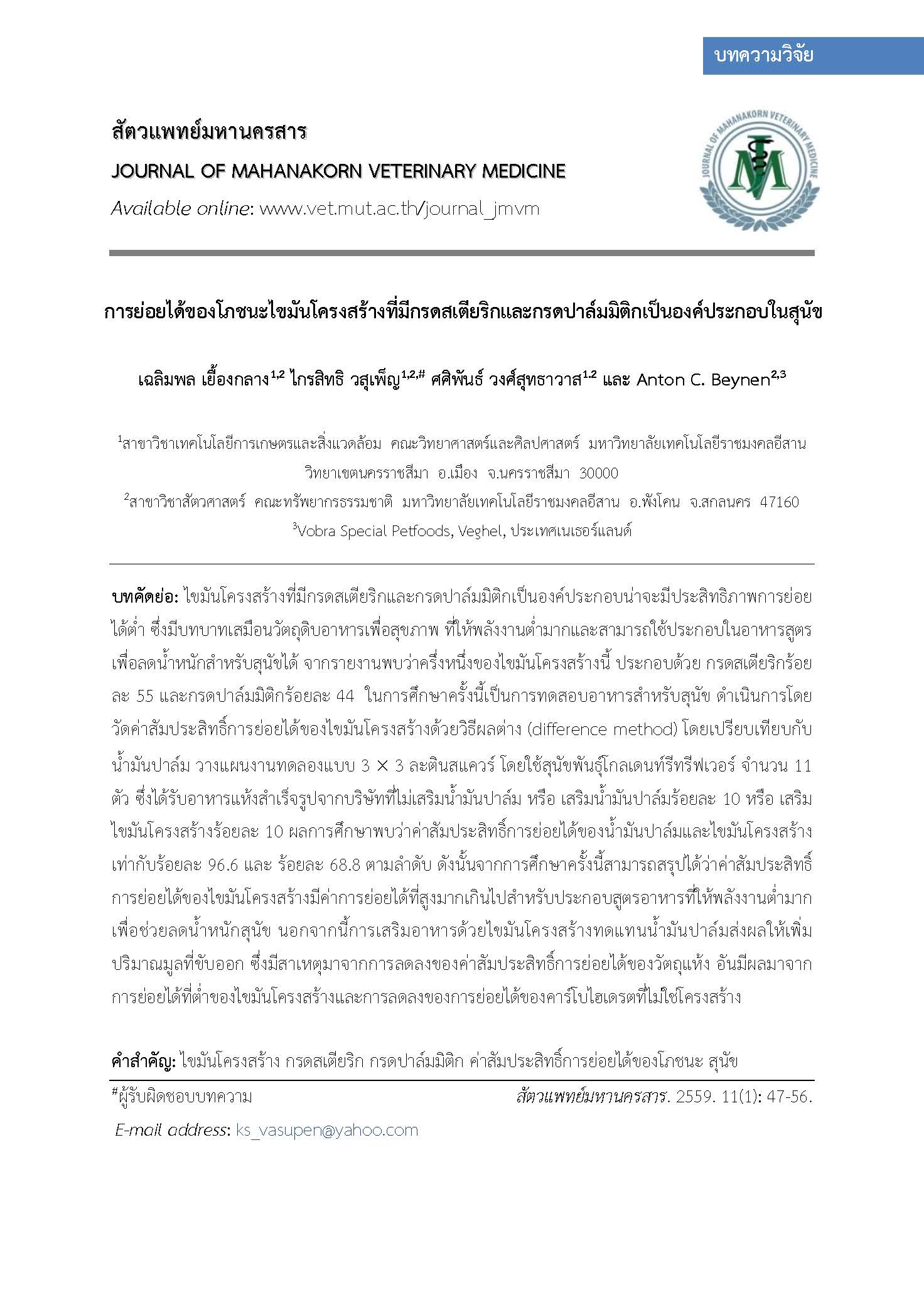Digestibility of a Structural Fat Consisting of Stearic and Palmitic Acid in Dogs
Main Article Content
Abstract
It was speculated that a structured fat consisting of stearic and palmitic acid would have sufficiently low digestibility that it could serve as functional ingredient in a very-low energy, weight-reduction diet for dogs. The fatty-acid moiety of the structured fat under study contained 55 % stearic acid and 44 % palmitic acid. In a feeding trial with dogs, the apparent digestibility of the structured fat was determined by the difference method and compared with that of palm oil. In a 3x3 Latin square-design, 11 dogs were fed a commercial dry food without or with 10% added palm oil or structured fat. The digestibility of palm oil was found to be 96.6 % and that of the structured fat was 68.8 %. It is concluded that the digestibility of the structured fat is too high for the formulation of a very-low energy, canine weight-reduction diet. The addition to the diet of the structured fat, instead of palm oil, increased the amount of feces. This was caused by a lower apparent digestibility of dietary dry matter, due to the low digestibility of the structured fat and a decrease in the digestibility of non-structural carbohydrates.
Article Details
References
Clifford, A.J., Smith, L.M., Creveling, R.K., Hamblin, C.L. and Clifford, C.K. 1986. Effects of dietary triglycerides on serum and liver lipids and sterol excretion of rats. J. Nutr. 116: 944-956.
German, A.J. 2006. The growing problem of obesity in dogs and cats. J. Nutr. 136: 1940S-1946S.
Gröner, T. and Pfeffer, E. 1997. Digestibility of organic matter and digestible energy in single ingredients of extruded dog feeds and their effects on faecal dry matter concentration and consistency. J. Anim. Physiol. Anim. Nutr. 77: 214-220.
Kealy, R.D., Lawler, D.F., Ballam, J.M., Mantz, S.L., Biery, D.N., Greeley, E.H., Segre, M., Smith, G.K. and Stowe, H.D. 2002. Effects of diet restriction on life span and age-related changes in dogs. J. Am. Vet. Med. Assoc. 220: 1315-1320.
Miller, K.W., Wood, F.E., Stuard, S.B. and Alden, C.L. 1991. A 20-month olestra feeding study in dogs. Fd Chem. Toxicol. 29: 427-435.
Mlacnik, E., Bockstahler, B.A., Műller, M., Tetrick, M.A., Nap, R.C. and Zentek J. 2006. Effects of caloric restriction and a moderate or intense physiotherapy program for treatment of lameness in overweight dogs with osteoarthritis. J. Am. Vet. Med. Assoc. 229: 1756-1760.
Vasupen, K., Yuangklang, C., Wongsuthavas, S., Srenanul, P., Mitchaothai, J. and Beynen, A.C. 2008. Macronutrient digestibility in Kadon pigs fed diets with isonitrogenous amounts of various carbohydrate sources. Trop. Anim. Health Prod. 40: 249-253.
Weber, M., Bissot, T., Servet, E., Sergheraert, R., Biourge, V. and German, A.J. 2007. A high-protein, high-fiber diet designed for weight loss improves satiety in dogs. J. Vet. Intern. Med. 21: 1203-1208.


